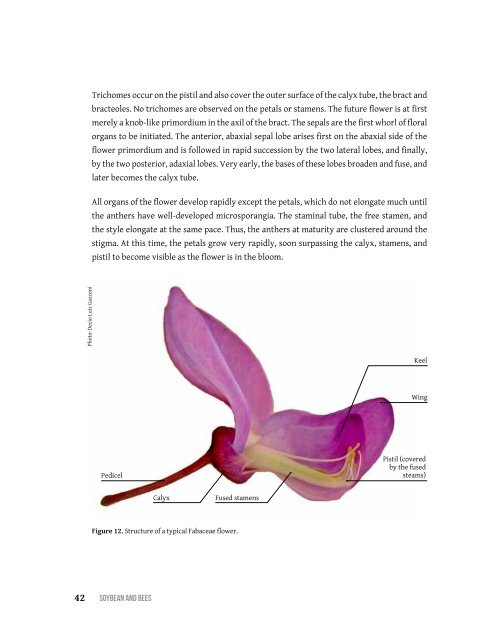Soybean and Bees
Create successful ePaper yourself
Turn your PDF publications into a flip-book with our unique Google optimized e-Paper software.
Trichomes occur on the pistil <strong>and</strong> also cover the outer surface of the calyx tube, the bract <strong>and</strong><br />
bracteoles. No trichomes are observed on the petals or stamens. The future flower is at first<br />
merely a knob-like primordium in the axil of the bract. The sepals are the first whorl of floral<br />
organs to be initiated. The anterior, abaxial sepal lobe arises first on the abaxial side of the<br />
flower primordium <strong>and</strong> is followed in rapid succession by the two lateral lobes, <strong>and</strong> finally,<br />
by the two posterior, adaxial lobes. Very early, the bases of these lobes broaden <strong>and</strong> fuse, <strong>and</strong><br />
later becomes the calyx tube.<br />
All organs of the flower develop rapidly except the petals, which do not elongate much until<br />
the anthers have well-developed microsporangia. The staminal tube, the free stamen, <strong>and</strong><br />
the style elongate at the same pace. Thus, the anthers at maturity are clustered around the<br />
stigma. At this time, the petals grow very rapidly, soon surpassing the calyx, stamens, <strong>and</strong><br />
pistil to become visible as the flower is in the bloom.<br />
Photo: Decio Luiz Gazzoni<br />
Keel<br />
Wing<br />
Pedicel<br />
Pistil (covered<br />
by the fused<br />
steams)<br />
Calyx<br />
Fused stamens<br />
Figure 12. Structure of a typical Fabaceae flower.<br />
42 SoybeAn <strong>and</strong> bees


